Opium
| Opium | |
|---|---|
 Opium poppy seed pod exuding latex from a cut | |
| Source plant(s) | Papaver somniferum |
| Part(s) of plant | Latexcapsuleseeds |
| Geographic origin | Uncertain, possibly Asia Minor,[1]or Spain, southern France and northwestern Africa[2] |
| Active ingredients | |
| Main producers | |
| Main consumers | Worldwide (#1: Iran)[3] |
| Legal status |
|
Opium(orpoppy tears,scientific name:Lachryma papaveris) is driedlatexobtained from the seedcapsulesof the opium poppyPapaver somniferum.[4]Approximately 12 percent of opium is made up of theanalgesicalkaloidmorphine,which is processed chemically to produceheroinand other syntheticopioidsfor medicinal use and for theillegal drug trade.The latex also contains the closely relatedopiatescodeineandthebaine,and non-analgesicalkaloidssuch aspapaverineandnoscapine.The traditional, labor-intensive method of obtaining the latex is to scratch ( "score" ) the immature seed pods (fruits) by hand; the latex leaks out and dries to a sticky yellowish residue that is later scraped off and dehydrated.
The English word for opium isborrowedfromLatin,which in turn comes fromAncient Greek:ὄπιον(ópion), adiminutiveof ὀπός (opós,"juice of a plant" ).[5] The wordmeconium(derived from the Greek for "opium-like", but now used to refer tonewbornstools) historically referred to related, weaker preparations made from other parts of the opium poppy or different species of poppies.[6]
The production methods have not significantly changed since ancient times. Through selective breeding of thePapaver somniferumplant, the content of thephenanthrenealkaloids morphine, codeine, and to a lesser extent thebaine has been greatly increased. In modern times, much of the thebaine, which often serves as the raw material for the synthesis foroxycodone,hydrocodone,hydromorphone,and othersemisyntheticopiates, originates from extractingPapaver orientaleorPapaver bracteatum.
For the illegal drug trade, themorphineis extracted from the opium latex, reducing the bulk weight by 88%. It is then converted toheroinwhich is almost twice as potent,[7]and increases the value by a similar factor. The reduced weight and bulk make it easier to smuggle.
History
[edit]TheMediterranean regioncontains the earliest archeological evidence of human use; the oldest known seeds date back to more than 5000BCE in theNeolithicage[8]with purposes such as food,anaesthetics,andritual.Evidence fromancient Greeceindicates that opium was consumed in several ways, including inhalation of vapors,suppositories,medical poultices,and as a combination withhemlockfor suicide.[9]Opium is mentioned in the most importantmedicaltexts of the ancient and medieval world, including theEbers Papyrusand the writings ofDioscorides,Galen,andAvicenna.Widespread medical use of unprocessed opium continued through theAmerican Civil Warbefore giving way tomorphineand its successors, which could be injected at a precisely controlled dosage.
Ancient use (pre-500 CE)
[edit]A little of it, taken as much as a grain of ervum is a pain-easer, and a sleep-causer, and a digester...but being drank too much it hurts, making men lethargical, and it kills.
Dioscorides,Introduction toThe Herbal of Dioscorides the Greek
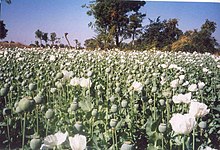
Opium has been actively collected since approximately 3400BCE.[10]
At least 17 finds ofPapaver somniferumfromNeolithicsettlements have been reported throughoutSwitzerland,Germany,andSpain,including the placement of large numbers of poppy seed capsules at a burial site (theCueva de los Murciélagos,or "Bat Cave", in Spain), which has been carbon-14 dated to 4200BCE. Numerous finds ofP. somniferumorP. setigerumfromBronze AgeandIron Agesettlements have also been reported.[11] The first known cultivation of opium poppies was inMesopotamia,approximately 3400BCE, bySumerians,who called the planthul gil,the "joy plant".[12][13]Tablets found atNippur,a Sumerian spiritual center south ofBaghdad,described the collection of poppy juice in the morning and its use in production of opium.[1]Cultivation continued in the Middle East by theAssyrians,who also collected poppy juice in the morning after scoring the pods with an iron scoop; they called the juicearatpa-pal,possibly the root ofPapaver.[14]Opium production continued under theBabyloniansandEgyptians.
Opium was used withpoison hemlockto put people quickly and painlessly to death. It was also used in medicine.Spongia somnifera,sponges soaked in opium, were used during surgery.[12]The Egyptians cultivatedopium thebaicumin famous poppy fields around 1300BCE. Opium was traded from Egypt by thePhoeniciansandMinoansto destinations around theMediterranean Sea,including Greece,Carthage,and Europe. By 1100BCE, opium was cultivated onCyprus,where surgical-quality knives were used to score the poppy pods, and opium was cultivated, traded, and smoked.[15]Opium was also mentioned after thePersianconquest of Assyria and Babylonian lands in the6th century BC.[1]
From the earliest finds, opium has appeared to have ritual significance, and anthropologists have speculated ancient priests may have used the drug as a proof of healing power.[12]In Egypt, the use of opium was generally restricted to priests, magicians, and warriors, its invention is credited to Thoth, and it was said to have been given by Isis to Ra as treatment for a headache.[1]A figure of the Minoan "goddess of the narcotics", wearing a crown of three opium poppies,c. 1300BCE, was recovered from the Sanctuary of Gazi, Crete, together with a simple smoking apparatus.[15][16]
The Greek godsHypnos(Sleep),Nyx(Night), andThanatos(Death) were depicted wreathed in poppies or holding them. Poppies also frequently adorned statues ofApollo,Asclepius,Pluto,Demeter,Aphrodite,KybeleandIsis,symbolizing nocturnal oblivion.[1]
Islamic societies (500–1500 CE)
[edit]
As the power of theRoman Empiredeclined, the lands to the south and east of the Mediterranean Sea became incorporated into theIslamic Empires.Some Muslims believehadiths,such as inSahih Bukhari,prohibit every intoxicating substance, though the use of intoxicants in medicine has been widely permitted by scholars.[17]Dioscorides'five-volumeDe Materia Medica,the precursor ofpharmacopoeias,remained in use (which was edited and improved in the Arabic versions[18]) from the 1st to 16th centuries, and described opium and the wide range of its uses prevalent in the ancient world.[19]

Between 400 and 1200 AD, Arab traders introduced opium to China, and to India by 700 AD.[20][1][13][21]The physicianMuhammad ibn Zakariya al-RaziofPersianorigin ( "Rhazes", 845–930 CE) maintained a laboratory and school inBaghdad,and was a student and critic ofGalen;he made use of opium in anesthesia and recommended its use for the treatment of melancholy inFi ma-la-yahdara al-tabib,"In the Absence of a Physician", a home medical manual directed toward ordinary citizens for self-treatment if a doctor was not available.[22][23]
The renownedAndalusianophthalmologicsurgeonAbu al-Qasim al-Zahrawi( "Abulcasis", 936–1013 CE) relied on opium andmandrakeas surgical anesthetics and wrote a treatise,al-Tasrif,that influenced medical thought well into the 16th century.[24]
The Persian physicianAbū ‘Alī al-Husayn ibn Sina( "Avicenna" ) described opium as the most powerful of the stupefacients, in comparison to mandrake and other highly effective herbs, inThe Canon of Medicine.The text lists medicinal effects of opium, such as analgesia, hypnosis, antitussive effects, gastrointestinal effects, cognitive effects, respiratory depression, neuromuscular disturbances, and sexual dysfunction. It also refers to opium's potential as a poison. Avicenna describes several methods of delivery and recommendations for doses of the drug.[25]This classic text was translated into Latin in 1175 and later into many other languages and remained authoritative until the 19th century.[26]Şerafeddin Sabuncuoğluused opium in the 14th-century Ottoman Empire to treatmigraineheadaches,sciatica,and other painful ailments.[27]
Reintroduction to Western medicine
[edit]
Manuscripts ofPseudo-Apuleius's 5th-century work from the 10th and 11th centuries refer to the use of wild poppyPapaver agresteorPapaver rhoeas(identified asP. silvaticum) instead ofP. somniferumfor inducing sleep and relieving pain.[28]
The use ofParacelsus'laudanumwas introduced to Western medicine in 1527, when Philippus Aureolus Theophrastus Bombastus von Hohenheim, better known by the name Paracelsus, claimed (dubiously) to have returned from wanderings in Arabia with a famous sword, within the pommel of which he kept "Stones of Immortality" compounded from opium thebaicum, citrus juice, and "quintessence of gold".[13][29][30]The name "Paracelsus" was a pseudonym signifying him the equal or better ofAulus Cornelius Celsus,whose text, which described the use of opium or a similar preparation, had recently been translated and reintroduced to medieval Europe.[31]The Canon of Medicine,the standard medical textbook that Paracelsus burned in a public bonfire three weeks after being appointed professor at theUniversity of Basel,also described the use of opium, though many Latin translations were of poor quality.[29]Laudanumwas originally the 16th-century term for a medicine associated with a particular physician that was widely well-regarded, but became standardized as "tinctureof opium ", a solution of opium inethanol,which Paracelsus has been credited with developing.[20]During his lifetime, Paracelsus was viewed as an adventurer who challenged the theories and mercenary motives of contemporary medicine with dangerous chemical therapies, but his therapies marked a turning point in Western medicine. In the 1660s, laudanum was recommended for pain, sleeplessness, and diarrhea byThomas Sydenham,[32]the renowned "father of English medicine" or "English Hippocrates", to whom is attributed the quote, "Among the remedies which it has pleased Almighty God to give to man to relieve his sufferings, none is so universal and so efficacious as opium."[33] Use of opium as a cure-all was reflected in the formulation ofmithridatiumdescribed in the 1728Chambers Cyclopedia,which included true opium in the mixture.
Eventually, laudanum became readily available and extensively used by the 18th century in Europe, especially England.[34]Compared to other chemicals available to 18th century regular physicians, opium was a benign alternative to arsenic, mercury, or emetics, and it was remarkably successful in alleviating a wide range of ailments. Due to the constipation often produced by the consumption of opium, it was one of the most effective treatments for cholera, dysentery, and diarrhea. As a cough suppressant, opium was used to treat bronchitis, tuberculosis, and other respiratory illnesses. Opium was additionally prescribed for rheumatism and insomnia.[35]Medical textbooks even recommended its use by people in good health, to "optimize the internal equilibrium of the human body".[20]
During the 18th century, opium was found to be a good remedy for nervous disorders. Due to its sedative and tranquilizing properties, it was used to quiet the minds of those with psychosis, help with people who were considered insane, and also to help treat patients with insomnia.[36]However, despite its medicinal values in these cases, it was noted that in cases of psychosis, it could cause anger or depression, and due to the drug's euphoric effects, it could cause depressed patients to become more depressed after the effects wore off because they would get used to being high.[36]
The standard medical use of opium persisted well into the 19th century. US presidentWilliam Henry Harrisonwas treated with opium in 1841, and in theAmerican Civil War,the Union Army used 175,000 lb (80,000 kg) of opium tincture and powder and about 500,000 opium pills.[1]During this time of popularity, users called opium "God's Own Medicine".[37]
One reason for the increase in opiate consumption in the United States during the 19th century was the prescribing and dispensing of legal opiates by physicians and pharmacists to women with "female complaints" (mostly to relieve menstrual pain andhysteria).[35]Because opiates were viewed as more humane than punishment or restraint, they were often used to treat the mentally ill. Between 150,000 and 200,000 opiate addicts lived in the United States in the late 19th century and between two-thirds and three-quarters of these addicts were women.[38]
Opium addiction in the later 19th century received a hereditary definition. Dr. George Beard in 1869 proposed his theory ofneurasthenia,a hereditary nervous system deficiency that could predispose an individual to addiction. Neurasthenia was increasingly tied in medical rhetoric to the "nervous exhaustion" suffered by many a white-collar worker in the increasingly hectic and industrialized U.S. life—the most likely potential clients of physicians.[citation needed]
Recreational use in Europe, the Middle East and the US (11th to 19th centuries)
[edit]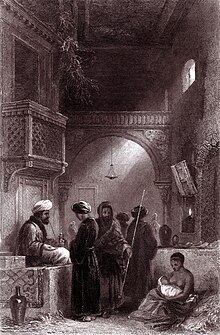
Soldiers returning home from theCrusadesin the 11th to 13th century brought opium with them.[20]Opium is said to have been used for recreational purposes from the 14th century onwards in Muslim societies. Ottoman and European testimonies confirm that from the 16th to the 19th centuries Anatolian opium was eaten in Constantinople as much as it was exported to Europe.[39]In 1573, for instance, a Venetian visitor to the Ottoman Empire observed many of the Turkish natives of Constantinople regularly drank a "certain black water made with opium" that makes them feel good, but to which they become so addicted, if they try to go without, they will "quickly die".[40]From drinking it, dervishes claimed the drugs bestowed them with visionary glimpses of future happiness.[41]Indeed, the Ottoman Empire supplied the West with opium long before China and India.[42]
Extensive textual and pictorial sources also show that poppy cultivation and opium consumption were widespread inSafavidIran[43]andMughalIndia.[44]
England
[edit]In England, opium fulfilled a "critical" role, as it did other societies, in addressing multifactorialpain,cough,dysentery,diarrhea,as argued byVirginia Berridge.[45]A medical panacea of the 19th century, "any respectable person" could purchase a range of hashish pastes and (later) morphine with complementary injection kit.[45]
Thomas De Quincey'sConfessions of an English Opium-Eater(1822), one of the first and most famousliterary accounts of opium addictionwritten from the point of view of an addict, details the pleasures and dangers of the drug. In the book, it is not Ottoman, nor Chinese, addicts about whom he writes, but English opium users: "I question whether any Turk, of all that ever entered the paradise of opium-eaters, can have had half the pleasure I had."[46]De Quincey writes about the great English Romantic poetSamuel Taylor Coleridge(1772–1834), whose "Kubla Khan"is also widely considered to be a poem of the opium experience. Coleridge began using opium in 1791 after developingjaundiceandrheumatic fever,and became a full addict after a severe attack of the disease in 1801, requiring 80–100 drops oflaudanumdaily.[47]
China
[edit]Recreational use in China
[edit]
The earliest clear description of the use of opium as arecreational drugin China came from Xu Boling, who wrote in 1483 that opium was "mainly used to aid masculinity, strengthen sperm and regain vigor", and that it "enhances the art of alchemists, sex and court ladies". He also described an expedition sent by theMing dynastyChenghua Emperorin 1483 to procure opium for a price "equal to that of gold" inHainan,Fu gian,Zhe gian g,SichuanandShaanxi,where it is close to the western lands ofXiyu.A century later,Li Shizhenlisted standard medical uses of opium in his renownedCompendium of Materia Medica(1578), but also wrote that "lay people use it for the art of sex," in particular the ability to "arrest seminal emission". This association of opium with sex continued in China until the end of the 19th century.
Opium smoking began as a privilege of the elite and remained a great luxury into the early 19th century. However, by 1861,Wang Taowrote that opium was used even by rich peasants, and even a small village without a rice store would have a shop where opium was sold.[48]
Recreational use of opium was part of a civilized and mannered ritual, akin to anEast Asian tea ceremony,prior to the extensive prohibitions that came later.[45]In places of gathering, often tea shops, or a person's home servings of opium were offered as a form of greeting and politeness. Often served with tea (in China) and with specific and fine utensils and beautifully carved wooden pipes. The wealthier the smoker, the finer and more expensive material used in ceremony.[45]The image of seedy underground, destitute smokers were often generated by anti-opium narratives and became a more accurate image of opium use following the effects of large scale opium prohibition in the 1880s.[45]
Prohibitions in China
[edit]Opium prohibition in China began in 1729, yet was followed by nearly two centuries of increasing opium use.A massive destruction of opiumby an emissary of the ChineseDaoguang Emperorin an attempt to stop opium smuggling by the British led to theFirst Opium War(1839–1842), in which Britain defeated China. After 1860, opium use continued to increase with widespread domestic production in China. By 1905, an estimated 25 percent of the male population were regular consumers of the drug. Recreational use of opium elsewhere in the world remained rare into late in the 19th century, as indicated by ambivalent reports of opium usage.[45]In 1906, 41,000 tons were produced, but because 39,000 tons of that year's opium were consumed in China, overall usage in the rest of the world was much lower.[49]These figures from 1906 have been criticized as overestimates.[50]

Smoking of opium came on the heels oftobaccosmoking and may have been encouraged by a briefban on the smokingof tobacco by the Ming emperor. The prohibition ended in 1644 with the coming of theQing dynasty,which encouraged smokers to mix in increasing amounts of opium.[1]In 1705,Wang Shizhenwrote, "nowadays, from nobility and gentlemen down to slaves and women, all are addicted to tobacco." Tobacco in that time was frequently mixed with other herbs (this continues withclove cigarettesto the modern day), and opium was one component in the mixture. Tobacco mixed with opium was calledmadak(ormadat) and became popular throughout China and its seafaring trade partners (such asTaiwan,Java,and thePhilippines) in the 17th century.[48]In 1712,Engelbert Kaempferdescribedaddictiontomadak:"No commodity throughout theIndiesis retailed with greater profit by theBataviansthan opium, which [its] users cannot do without, nor can they come by it except it be brought by the ships of the Batavians fromBengalandCoromandel."[21]
Fueled in part by the 1729 ban onmadak,which at first effectively exempted pure opium as a potentially medicinal product, the smoking of pure opium became more popular in the 18th century. In 1736, the smoking of pure opium was described byHuang Shujing,involving a pipe made from bamboo rimmed with silver, stuffed with palm slices and hair, fed by a clay bowl in which a globule of molten opium was held over the flame of an oil lamp. This elaborate procedure, requiring the maintenance of pots of opium at just the right temperature for a globule to be scooped up with a needle-like skewer for smoking, formed the basis of a craft of "paste-scooping" by which servant girls could become prostitutes as the opportunity arose.[48]
Chinese diaspora in the West
[edit]TheChinese Diasporain the West (1800s to 1949) first began to flourish during the 19th century due to famine and political upheaval, as well as rumors of wealth to be had outside ofSoutheast Asia.Chinese emigrants to cities such asSan Francisco,London,andNew York Citybrought with them the Chinese manner of opium smoking, and the social traditions of theopium den.[51][52]TheIndian Diasporadistributed opium-eaters in the same way, and both social groups survived as "lascars"(seamen) and"coolies"(manual laborers). French sailors provided another major group of opium smokers, having gotten the habit while inFrench Indochina,where the drug was promoted and monopolized by the colonial government as a source of revenue.[53][54]Among white Europeans, opium was more frequently consumed aslaudanumor inpatent medicines.Britain's All-India Opium Act of 1878 formalized ethnic restrictions on the use of opium, limiting recreational opium sales to registered Indian opium-eaters and Chinese opium-smokers only and prohibiting its sale to workers from Burma.[55]Likewise, in San Francisco, Chinese immigrants were permitted to smoke opium, so long as they refrained from doing so in the presence of whites.[51]
Because of the low social status of immigrant workers, contemporary writers and media had little trouble portraying opium dens as seats of vice,white slavery,gambling, knife- and revolver-fights, and a source for drugs causing deadly overdoses, with the potential to addict and corrupt the white population. By 1919, anti-Chinese riots attackedLimehouse,theChinatown of London.Chinese men were deported for playingkenoand sentenced to hard labor for opium possession. Due to this, both the immigrant population and the social use of opium fell into decline.[56][57]Yet despite lurid literary accounts to the contrary, 19th-century London was not a hotbed of opium smoking. The total lack of photographic evidence of opium smoking in Britain, as opposed to the relative abundance of historical photos depicting opium smoking in North America and France, indicates the infamousLimehouseopium-smoking scene was little more than fantasy on the part of British writers of the day, who were intent on scandalizing their readers while drumming up the threat of the "yellow peril".[58][59]
Prohibition and conflict in China
[edit]This sectionneeds additional citations forverification.(February 2021) |

A large scale opium prohibition attempt began in 1729, when theQingYongzheng Emperor,disturbed bymadaksmoking at court and carrying out the government's role of upholdingConfucianvirtues, officially prohibited the sale of opium, except for a small amount for medicinal purposes. The ban punished sellers andopium denkeepers, but not users of the drug.[21]Opium was banned completely in 1799, and this prohibition continued until 1860.[60]
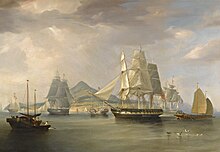
During the Qing dynasty, China opened itself to foreign trade under theCanton Systemthrough the port ofGuangzhou(Canton), with traders from theEast India Companyvisiting the port by the 1690s. Due to the growing British demand for Chinese tea and the Chinese Emperor's lack of interest in British commodities other than silver, British traders resorted to trade in opium as a high-value commodity for which China was not self-sufficient. The English traders had been purchasing small amounts of opium from India for trade sinceRalph Fitchfirst visited in the mid-16th century.[21]Trade in opium was standardized, with production of balls of raw opium, 1.1–1.6 kg (2.4–3.5 lb), 30% water content, wrapped in poppy leaves and petals, and shipped in chests of 60–65 kg (132–143 lb) (onepicul).[21]Chests of opium were sold in auctions inCalcuttawith the understanding that the independent purchasers would then smuggle it into China.
China had a positive balance sheet in trading with the British, which led to a decrease of the British silver stocks. Therefore, the British tried to encourage Chinese opium use to enhance their balance, and they delivered it from Indian provinces under British control. In India, its cultivation, as well as the manufacture and traffic to China, were subject to theBritish East India Company(BEIC), as a strict monopoly of the British government.[61]There was an extensive and complicated system of BEIC agencies involved in the supervision and management of opium production and distribution in India. Bengal opium was highly prized, commanding twice the price of the domestic Chinese product, which was regarded as inferior in quality.[49]
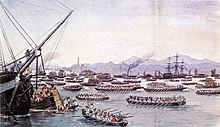
Some competition came from the newly independent United States, which began to compete in Guangzhou, selling Turkish opium in the 1820s. Portuguese traders also brought opium from the independent Malwa states of western India, although by 1820, the British were able to restrict this trade by charging "pass duty" on the opium when it was forced to pass through Bombay to reach anentrepot.[21] Despite drastic penalties and continued prohibition of opium until 1860, opium smuggling rose steadily from 200 chests per year under theYongzheng Emperorto 1,000 under theQianlong Emperor,4,000 under theJiaqing Emperor,and 30,000 under theDaoguang Emperor.[62]This illegal sale of opium, which has been called "the most long continued and systematic international crime of modern times",[63]became one of the world's most valuable single commodity trades, and between 1814 and 1850, sucked out 11 percent of China's money supply.[64]
In response to the ever-growing number of Chinese people becoming addicted to opium, the QingDaoguang Emperortook strong action to halt the smuggling of opium, including the seizure of cargo. In 1838, the Chinese CommissionerLin Zexudestroyed20,000 chests of opium (approximately 2,660,000 pounds) in Guangzhou in a river.[21]Given that a chest of opium was worth nearlyUS$1,000in 1800, this was a substantial economic loss. The British queenVictoria,not willing to replace the cheap opium with costly silver, began theFirst Opium Warin 1840, the British winning Hong Kong and trade concessions in the first of a series ofUnequal Treaties.[citation needed]
The opium trade incurred intense enmity from the later British Prime MinisterWilliam Ewart Gladstone.[65]As a member of Parliament, Gladstone called it "most infamous and atrocious" referring to the opium trade between China and British India in particular.[66]Gladstone was fiercely against both of theOpium WarsBritain waged in China in theFirst Opium Warinitiated in 1840 and theSecond Opium Warinitiated in 1857, denounced British violence against Chinese, and was ardently opposed to the British trade in opium to China.[67]Gladstone lambasted it as "Palmerston'sOpium War "and said that he felt" in dread of the judgments of God upon England for our national iniquity towards China "in May 1840.[68]A famous speech was made by Gladstone in Parliament against theFirst Opium War.[69][70]Gladstone criticized it as "a war more unjust in its origin, a war more calculated in its progress to cover this country with permanent disgrace".[71]His hostility to opium stemmed from the effects of opium brought upon his sister Helen.[72]Due to the First Opium war brought on byPalmerston,there was initial reluctance to join the government of Peel on part of Gladstone before 1841.[73]

Following China's defeat in theSecond Opium Warin 1858, China was forced to legalize opium and began massive domestic production. Importation of opium peaked in 1879 at 6,700 tons, and by 1906, China was producing 85 percent of the world's opium, some 35,000 tons, and 27 percent of its adult male population regularly used opium—13.5million people consuming 39,000 tons of opium yearly.[49]From 1880 to the beginning of the Communist era, the British attempted to discourage the use of opium in China, but this effectively promoted the use of morphine, heroin, and cocaine, further exacerbating the problem of addiction.[45]
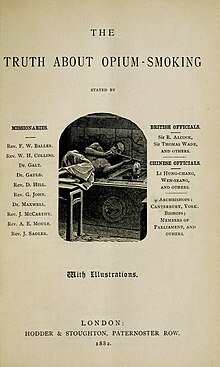
Scientific evidence of the pernicious nature of opium use was largely undocumented in the 1890s, when Protestantmissionariesin China decided to strengthen their opposition to the trade by compiling data which would demonstrate the harm the drug did. Faced with the problem that many Chinese associated Christianity with opium, partly due to the arrival of early Protestant missionaries on opium clippers, at the 1890 Shanghai Missionary Conference, they agreed to establish the Permanent Committee for the Promotion of Anti-Opium Societies in an attempt to overcome this problem and to arouse public opinion against the opium trade. The members of the committee wereJohn Glasgow Kerr,MD, American Presbyterian Mission inGuangzhou(Canton);B.C. Atterbury, MD,American Presbyterian Mission inBeijing(Peking); ArchdeaconArthur E. Moule,Church Missionary Society inShanghai;Henry Whitney, MD, American Board of Commissioners for foreign Missions inFuzhou;the Rev. Samuel Clarke, China Inland Mission inGuiyang;the Rev.Arthur Gostick Shorrock,English Baptist Mission inTaiyuan;and the Rev.Griffith John,London Mission Society inHankou.[74]These missionaries were generally outraged over the British government'sRoyal Commission on Opiumvisiting India but not China. Accordingly, the missionaries first organized theAnti-Opium League in Chinaamong their colleagues in every mission station in China. American missionaryHampden Coit DuBoseacted as first president. This organization, which had elected national officers and held an annual national meeting, was instrumental in gathering data from every Western-trained medical doctor in China, which was then published asWilliam Hector ParkcompiledOpinions of Over 100 Physicians on the Use of Opium in China(Shanghai: American Presbyterian Mission Press, 1899). The vast majority of these medical doctors were missionaries; the survey also included doctors who were in private practices, particularly in Shanghai andHong Kong,as well as Chinese who had been trained in medical schools in Western countries. In England, the home director of theChina Inland Mission,Benjamin Broomhall,was an active opponent of the opium trade, writing two books to promote the banning of opium smoking:The Truth about Opium SmokingandThe Chinese Opium Smoker.In 1888, Broomhall formed and became secretary of the Christian Union for the Severance of the British Empire with the Opium Traffic and editor of its periodical,National Righteousness.He lobbied theBritish Parliamentto stop the opium trade. He andJames Laidlaw Maxwellappealed to the London Missionary Conference of 1888 and the Edinburgh Missionary Conference of 1910 to condemn the continuation of the trade. When Broomhall was dying, his son Marshall read to him fromThe Timesthe welcome news that an agreement had been signed ensuring the end of the opium trade within two years.
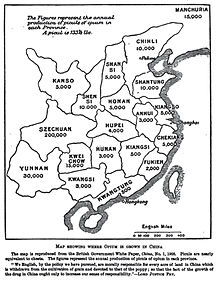
Official Chinese resistance to opium was renewed on September 20, 1906, with an antiopium initiative intended to eliminate the drug problem within 10 years. The program relied on the turning of public sentiment against opium, with mass meetings at whichopium paraphernaliawere publicly burned, as well as coercive legal action and the granting of police powers to organizations such as the Fu gian Anti-Opium Society. Smokers were required to register for licenses for gradually reducing rations of the drug. Action against opium farmers centered upon a highly repressive incarnation of law enforcement in which rural populations had their property destroyed, their land confiscated and/or were publicly tortured, humiliated and executed.[75]Addicts sometimes turned to missionaries for treatment for their addiction, though many associated these foreigners with the drug trade. The program was counted as a substantial success, with a cessation of direct British opium exports to China (but not Hong Kong)[76]and most provinces declared free of opium production. Nonetheless, the success of the program was only temporary, with opium use rapidly increasing during the disorder following the death ofYuan Shikaiin 1916.[77]Opium farming also increased, peaking in 1930 when theLeague of Nationssingled China out as the primary source of illicit opium in East and Southeast Asia. Many[78]local powerholders facilitated the trade during this period to finance conflicts over territory and political campaigns. In some areas food crops were eradicated to make way for opium, contributing to famines in Guizhou and Shaanxi Provinces between 1921 and 1923, and food deficits in other provinces.
Beginning in 1915, Chinese nationalist groups came to describe the period of military losses andUnequal Treatiesas the "Century of National Humiliation", later defined to end with the conclusion of theChinese Civil Warin 1949.[79]
In the northern provinces ofNingxiaandSuiyuanin China,Chinese MuslimGeneralMa Fuxiangboth prohibited and engaged in the opium trade. It was hoped that Ma Fuxiang would have improved the situation, since Chinese Muslims were well known for opposition to smoking opium.[80]Ma Fuxiang officially prohibited opium and made it illegal in Ningxia, but theGuominjunreversed his policy; by 1933, people from every level of society were abusing the drug, and Ningxia was left in destitution.[81]In 1923, an officer of theBank of ChinafromBaotoufound out that Ma Fuxiang was assisting the drug trade in opium which helped finance his military expenses. He earnedUS$2millionfrom ta xing those sales in 1923. General Ma had been using the bank, a branch of the Government of China's exchequer, to arrange for silver currency to be transported to Baotou to use it to sponsor the trade.[82]
The opium trade under theChinese Communist Partywas important to its finances in the 1940s.[83]Peter Vladimirov's diary provided a first hand account.[84]Chen Yung-faprovided a detailed historical account of how the opium trade was essential to the economy of Yan'an during this period.[85]MitsubishiandMitsuiwere involved in the opium trade during the Japanese occupation of China.[86]
Mao Zedonggovernment is generally credited with eradicating both consumption and production of opium during the 1950s using unrestrained repression and social reform.[87][88]Ten million addicts were forced into compulsory treatment, dealers were executed, and opium-producing regions were planted with new crops. Remaining opium production shifted south of the Chinese border into theGolden Triangleregion.[49]The remnant opium trade primarily served Southeast Asia, but spread to American soldiers during theVietnam War;based on a study of opiate use in soldiers returning to the United States in 1971, 20 percent of participants were dependent enough to experience withdrawal symptoms.[89]
Prohibition outside China
[edit]There were no legal restrictions on the importation or use of opium in the United States until the San Francisco Opium Den Ordinance, which banned dens for public smoking of opium in 1875, a measure fueled byanti-Chinese sentimentand the perception that whites were starting to frequent the dens. This was followed by an 1891 California law requiring that narcotics carry warning labels and that their sales be recorded in a registry; amendments to the California Pharmacy and Poison Act in 1907 made it a crime to sell opiates without a prescription, and bans on possession of opium oropium pipesin 1909 were enacted.[90]
At the US federal level, the legal actions taken reflected constitutional restrictions under theenumerated powersdoctrine prior to reinterpretation of thecommerce clause,which did not allow the federal government to enact arbitrary prohibitions, but did permit arbitrary taxation.[91]Beginning in 1883, opium importation was taxed atUS$6toUS$300per pound, until the Opium Exclusion Act of 1909 prohibited the importation of opium altogether. In a similar manner, theHarrison Narcotics Tax Actof 1914, passed in fulfillment of theInternational Opium Conventionof 1912, nominally placed a tax on the distribution of opiates, but served as ade factoprohibition of the drugs. Today, opium is regulated by theDrug Enforcement Administrationunder theControlled Substances Act.
Following passage of a Colonial Australian law in 1895, Queensland'sAboriginals Protection and Restriction of the Sale of Opium Act 1897addressed opium addiction amongAboriginal people,though it soon became a general vehicle for depriving them of basic rights by administrative regulation. By 1905 all Australian states and territories had passed similar laws making prohibitions to Opium sale. Smoking and possession was prohibited in 1908.[92]
Hardening of Canadian attitudes toward Chinese opium users and fear of a spread of the drug into the white population led to the effective criminalization of opium for nonmedical use in Canada between 1908 and the mid-1920s.[93]
In 1909, theInternational Opium Commissionwas founded, and by 1914, 34 nations had agreed that the production and importation of opium should be diminished. In 1924, 62 nations participated in a meeting of the commission. Subsequently, this role passed to theLeague of Nations,and all signatory nations agreed to prohibit the import, sale, distribution, export, and use of all narcotic drugs, except for medical and scientific purposes. This role was later taken up by theInternational Narcotics Control Boardof the United Nations underArticle 23of theSingle Convention on Narcotic Drugs,and subsequently under theConvention on Psychotropic Substances.Opium-producing nations are required to designate agovernment agencyto take physical possession of licit opium crops as soon as possible after harvest and conduct all wholesaling and exporting through that agency.[1]
Indochina tax
[edit]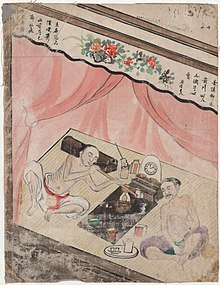
From 1897 to 1902,Paul Doumer(laterPresident of France) wasGovernor-General of French Indochina.Upon his arrival the colonies were losing millions of francs each year. Determined to put them on a paying basis he levied taxes on various products, opium among them. The Vietnamese, Cambodians and Laotians who could or would not pay these taxes, lost their houses and land, and often became day laborers. Evidently, resorting to this means of gaining income gave France a vested interest in the continuation of opium use among the population of Indochina.[94]
Regulation in Britain and the United States
[edit]Before the 1920s, regulation in Britain was controlled by pharmacists. Pharmacists who were found to have prescribed opium for illegitimate uses and anyone found to have sold opium without proper qualifications would be prosecuted.[95]With the passing of the Rolleston Act in Britain in 1926, doctors were allowed to prescribe opiates such as morphine and heroin if they believed their patients demonstrated a medical need. Because addiction was viewed as a medical problem rather than an indulgence, doctors were permitted to allow patients to wean themselves off opiates rather than cutting off any opiate use altogether.[96]The passing of the Rolleston Act put the control of opium use in the hands of medical doctors instead of pharmacists. Later in the 20th century, addiction to opiates, especially heroin in young people, continued to rise and so the sale and prescription of opiates was limited to doctors in treatment centers. If these doctors were found to be prescribing opiates without just cause, then they could lose their license to practice or prescribe drugs.[96]
Abuse of opium in the United States began in the late 19th century and was largely associated with Chinese immigrants. During this time the use of opium had little stigma; the drug was used freely until 1882 when a law was passed to confine opium smoking to specific dens.[96]Until the full ban on opium-based products came into effect just after the beginning of the twentieth century, physicians in the US considered opium a miracle drug that could help with many ailments. Therefore, the ban on said products was more a result of negative connotations towards its use and distribution by Chinese immigrants who were heavily persecuted during this particular period in history.[96]As the 19th century progressed however, doctorHamilton Wrightworked to decrease the use of opium in the US by submitting the Harrison Act to congress. This act put taxes and restrictions on the sale and prescription of opium, as well as trying to stigmatize the opium poppy and its derivatives as "demon drugs", to try to scare people away from them.[96]This act and the stigma of a demon drug on opium, led to the criminalization of people that used opium-based products. It made the use and possession of opium and any of its derivatives illegal. The restrictions were recently redefined by the Federal Controlled Substances Act of 1970.[97][98]
20th-century use
[edit]Opium production in China and the rest of East Asia was nearly wiped out after WWII, however, sustained covert support by the United StatesCentral Intelligence Agencyfor theThaiNorthern Army and the Chinese NationalistKuomintang army invading Burmafacilitated production and trafficking of the drug from Southeast Asia for decades, with the region becoming a major source of world supplies.[99]
During the Communist era in Eastern Europe, poppy stalks sold in bundles by farmers were processed by users with household chemicals to makekompot( "Polish heroin"), and poppy seeds were used to producekoknar,an opiate.[100]
Obsolescence
[edit]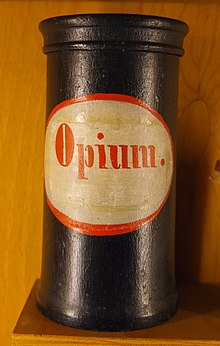
Globally, opium has gradually been superseded by a variety of purified, semi-synthetic, and syntheticopioidswith progressively stronger effects, and by othergeneral anesthetics.This process began in 1804, whenFriedrich Wilhelm Adam Sertürnerfirst isolated morphine from the opium poppy.[101][102]

The process continued until 1817, when Sertürner published his results after thirteen years of research and a nearly disastrous trial on himself and three boys.[103]The great advantage of purified morphine was that a patient could be treated with a known dose—whereas with raw plant material, asGabriel Fallopiusonce lamented, "if soporifics are weak they do not help; if they are strong they are exceedingly dangerous."
Morphine was the first pharmaceutical isolated from a natural product, and this success encouraged the isolation of other alkaloids: by 1820, isolations ofnoscapine,strychnine,veratrine,colchicine,caffeine,andquininewere reported. Morphine sales began in 1827, byHeinrich Emanuel Merckof Darmstadt, and helped him expand his family pharmacy into theMerck KGaApharmaceutical company.Codeinewas isolated in 1832 byPierre Jean Robiquet.[citation needed]
The use ofdiethyl etherandchloroformforgeneral anesthesiabegan in 1846–1847, and rapidly displaced the use of opiates andtropanealkaloids fromSolanaceaedue to their relative safety.[104]
Heroin,the first semi-synthetic opioid, was first synthesized in 1874, but was not pursued until its rediscovery in 1897 byFelix Hoffmannat theBayerpharmaceutical company inElberfeld,Germany.From 1898 to 1910 heroin was marketed as a non-addictive morphine substitute and cough medicine for children. Because the lethal dose of heroin was viewed as a hundred times greater than its effective dose, heroin was advertised as a safer alternative to other opioids.[105]By 1902, sales made up 5 percent of the company's profits, and "heroinism" had attracted media attention.[106]Oxycodone,athebainederivative similar tocodeine,was introduced by Bayer in 1916 and promoted as a less-addictive analgesic. Preparations of the drug such asoxycodone with paracetamolandextended releaseoxycodone remain popular to this day.[citation needed]
A range of syntheticopioidssuch asmethadone(1937),pethidine(1939),fentanyl(late 1950s), and derivatives thereof have been introduced, and each is preferred for certain specialized applications. Nonetheless, morphine remains the drug of choice for Americancombat medics,who carry packs ofsyrettescontaining 16 milligrams each for use on severely wounded soldiers.[107]No drug has been found that can match the painkilling effect ofopioidswithout also duplicating much of their addictive potential.[citation needed]
Modern production and use
[edit]This section needs to beupdated.(October 2022) |
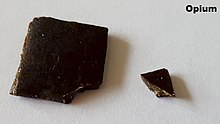
Opium wasprohibitedin many countries during the early 20th century, leading to the modern pattern of opium production as a precursor for illegalrecreational drugsor tightly regulated, highly taxed, legal prescription drugs. In 1980, 2,000 tons of opium supplied all legal and illegal uses.[21]Worldwide production in 2006 was 6610 tonnes[108]—about one-fifth the level of production in 1906; since then, opium production has fallen.[citation needed]
In 2002, the price for one kilogram of opium wasUS$300for the farmer,US$800for purchasers inAfghanistan,andUS$16,000on the streets of Europe before conversion into heroin.[109]
Opium production increased considerably, surpassing 5,000 tons in 2002 and reaching 8,600 tons in Afghanistan and 840 tons in theGolden Trianglein 2014.[110][111]TheWorld Health Organizationhas estimated that current production of opium would need to increase fivefold to account for total global medical need.[50]Solar energy panels in use in Afghanistan have allowed farmers to dig their wells deeper, leading to a bumper crop of opium year after year.[112]In a 2023 report, poppy cultivation in southern Afghanistan was reduced by over 80% as a result of Taliban campaigns to stop its use toward opium. This included a 99% reduction of opium growth in theHelmand Province.[113]In November 2023, a U.N report showed that in the entirety of Afghanistan, poppy cultivation dropped by over 95%, removing it from its place as being the world's largest opium producer.[114][115]
Papaver somniferum
[edit]Opium poppies are popular and attractive garden plants, whose flowers vary greatly in color, size and form. A modest amount of domestic cultivation in private gardens is not usually subject to legal controls.[clarification needed]In part, this tolerance reflects variation in addictive potency. A cultivar for opium production,Papaver somniferum L. elite,contains 91.2 percent morphine, codeine, and thebaine in its latex alkaloids, whereas in the latex of the condiment cultivar "Marianne", these three alkaloids total only 14.0 percent. The remaining alkaloids in the latter cultivar are primarilynarcotolineandnoscapine.[116]
Seed capsules can be dried and used for decorations, but they also contain morphine, codeine, and other alkaloids. These pods can be boiled in water to produce a bitterteathat induces a long-lasting intoxication. If allowed to mature, poppy pods (poppy straw) can be crushed and used to produce lower quantities ofmorphinans.In poppies subjected to mutagenesis and selection on a mass scale, researchers have been able to use poppy straw to obtain large quantities oforipavine,a precursor toopioidsand antagonists such asnaltrexone.[117]Although millennia older, the production of poppy head decoctions can be seen as a quick-and-dirty variant of the Kábáy poppy straw process, which since its publication in 1930 has become the major method of obtaining licit opium alkaloids worldwide, as discussed inMorphine.
Poppy seedsare a common and flavorsome topping for breads and cakes. One gram of poppy seeds contains up to 33 micrograms of morphine and 14 micrograms of codeine, and theSubstance Abuse and Mental Health Services Administrationin theUnited Statesformerly mandated that all drug screening laboratories use a standard cutoff of 300 nanograms per milliliter in urine samples. A single poppy seed roll (0.76 grams of seeds) usually did not produce a positivedrug test,but a positive result was observed from eating two rolls. A slice of poppy seed cake containing nearly five grams of seeds per slice produced positive results for 24 hours. Such results are viewed asfalse positiveindications of drug use and were the basis ofa legal defense.[118][119]On November 30, 1998, the standard cutoff was increased to 2000 nanograms (two micrograms) per milliliter.[120]Confirmation by gas chromatography-mass spectrometry will distinguish amongst opium and variants including poppy seeds, heroin, and morphine and codeine pharmaceuticals by measuring the morphine:codeine ratio and looking for the presence of noscapine and acetylcodeine, the latter of which is only found in illicitly produced heroin, and heroin metabolites such as 6-monoacetylmorphine.[121]
Harvesting and processing
[edit]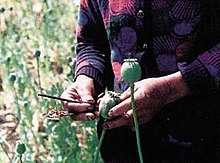
When grown for opium production, the skin of the ripening pods of these poppies is scored by a sharp blade at a time carefully chosen so that rain, wind, and dew cannot spoil the exudation of white, milkylatex,usually in the afternoon. Incisions are made while the pods are still raw, with no more than a slight yellow tint, and must be shallow to avoid penetrating hollow inner chambers orloculiwhile cutting into the lactiferous vessels. In the Indian Subcontinent, Afghanistan, Central Asia and Iran, the special tool used to make the incisions is called anushtaror "nishtar" (fromPersian,meaning a lancet) and carries three or four blades three millimeters apart, which are scored upward along the pod. Incisions are made three or four times at intervals of two to three days, and each time the "poppy tears", which dry to a sticky brown resin, are collected the following morning. One acre harvested in this way can produce three to five kilograms of raw opium.[122]In theSoviet Union,pods were typically scored horizontally, and opium was collected three times, or else one or two collections were followed by isolation of opiates from the ripe capsules. Oil poppies, an alternative strain ofP. somniferum,were also used for production of opiates from their capsules and stems.[123]A traditional Chinese method of harvesting opium latex involved cutting off the heads and piercing them with a coarse needle then collecting the dried opium 24 to 48 hours later.
Raw opium may be sold to a merchant or broker on the black market, but it usually does not travel far from the field before it is refined intomorphine base,because pungent, jelly-like raw opium is bulkier and harder to smuggle. Crude laboratories in the field are capable of refining opium into morphine base by a simpleacid-base extraction.A sticky, brown paste, morphine base is pressed into bricks and sun-dried, and can either be smoked, prepared into other forms or processed into heroin.[13]
Other methods of preparation (besides smoking), include processing into regular opiumtincture(tinctura opii),laudanum,paregoric(tinctura opii camphorata),herbal wine(e.g.,vinum opii), opium powder (pulvis opii), opiumsirup(sirupus opii) and opium extract (extractum opii).[124]Vinum opii is made by combining sugar,white wine,cinnamon,andcloves.Opium syrup is made by combining 97.5 part sugar syrup with 2.5 parts opium extract. Opium extract (extractum opii) finally can be made by macerating raw opium with water. To make opium extract, 20 parts water are combined with 1 part raw opium which has been boiled for 5 minutes (the latter to ease mi xing ).[124]
Heroin is widely preferred because of increased potency. One study in postaddicts found heroin to be approximately 2.2 times more potent thanmorphineby weight with a similar duration; at these relative quantities, they could distinguish the drugs subjectively but had no preference.[125]Heroin was also found to be twice as potent as morphine in surgical anesthesia.[126]Morphine is converted into heroin by a simple chemical reaction withacetic anhydride,followed by purification.[127][128]Especially in Mexican production, opium may be converted directly to "black tar heroin"in a simplified procedure. This form predominates in the U.S. west of the Mississippi. Relative to other preparations of heroin, it has been associated with a dramatically decreased rate of HIV transmission amongintravenous drug users(4 percent in Los Angeles vs. 40 percent in New York) due to technical requirements of injection, although it is also associated with greater risk of venoussclerosisandnecrotizing fasciitis.[129]
Illegal production
[edit]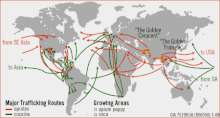
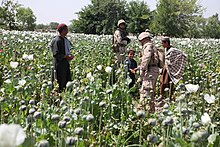
Afghanistanwas formerly the primary producer of the drug. Having regularly producing 70 percent of the world's opium, Afghanistan decreased production to 74 tons per year under a ban by theTalibanin 2000, a move which cut production by 94 percent. A year later, after American and British troopsinvaded Afghanistan,removed the Taliban and installed the interim government, the land under cultivation leapt back to 285 square miles (740 km2), with Afghanistan supplanting Burma to become the world's largest opium producer once more. Opium production increased rapidly in Afghanistan from that point,[130][131]reaching an all-time high in 2006. According toDEAstatistics, Afghanistan's production of oven-dried opium increased to 1,278 tons in 2002, more than doubled by 2003, and nearly doubled again during 2004. In late 2004, the U.S. government estimated that 206,000 hectares were under poppy cultivation, 4.5 percent of the country's total cropland, and produced 4,200 metric tons of opium, 76 percent of the world's supply, yielding 60 percent of Afghanistan's gross domestic product.[132]In 2006, theUN Office on Drugs and Crimeestimated production to have risen 59 percent to 165,000 hectares (407,000 acres) in cultivation, yielding 6,100 tons of opium, 82 percent of the world's supply.[133]The value of the resulting heroin was estimated atUS$3.5billion,of which Afghan farmers were estimated to have receivedUS$700millionin revenue. For farmers, the crop can be up to ten times more profitable than wheat. The price of opium is aroundUS$138per kilo. Opium production has led to rising tensions in Afghan villages. Though direct conflict has yet to occur, the opinions of the new class of young rich men involved in the opium trade are at odds with those of the traditional village leaders.[134]
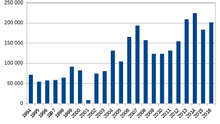
An increasingly large fraction of opium is processed into morphine base and heroin in drug labs in Afghanistan. Despite an international set of chemical controls designed to restrict availability ofacetic anhydride,it enters the country, perhaps through its Central Asian neighbors which do not participate. A counternarcotics law passed in December 2005 requires Afghanistan to develop registries or regulations for tracking, storing, and owning acetic anhydride.[135]In November 2023, a U.N report showed that in the entirety of Afghanistan, poppy cultivation dropped by over 95%, removing it from its place as being the world's largest opium producer.[114][115]
Besides Afghanistan, smaller quantities of opium are produced in Pakistan, theGolden Triangleregion of Southeast Asia (particularlyBurma), Colombia, Guatemala, and Mexico.
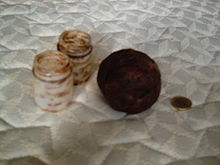
Chinese production mainly trades with and profits from North America. In 2002, they were seeking to expand through eastern United States. In the post 9/11 era, trading between borders became difficult and because new international laws were set into place, the opium trade became more diffused. Power shifted from remote to high-end smugglers and opium traders. Outsourcing became a huge factor for survival for many smugglers and opium farmers.[136]
In 2023BurmaovertookAfghanistanand became the world's largest producer of opium, producing 1080 metric tones according theUNSoutheast Asia Opium Survey report.[137]
Legal production
[edit]Legal opium production is allowed under theUnited Nations Single Convention on Narcotic Drugsand other international drug treaties, subject to strict supervision by thelaw enforcement agenciesof individual countries. The leading legal production method is the Robertson-Gregory process,whereby the entire poppy, excluding roots and leaves, is mashed and stewed in dilute acid solutions. Thealkaloidsare then recovered viaacid-base extractionand purified. The exact date of its discovery is unknown, but it was described by Wurtz in hisDictionnaire de chimie pure et appliquéepublished in 1868.[138]
Legal opium production in Indiais much more traditional. As of 2008, opium was collected by farmers who were licensed to grow 0.1 hectares (0.25 acres) of opium poppies, who to maintain their licences needed to sell 56 kilograms of unadulterated raw opium paste. The price of opium paste is fixed by the government according to the quality and quantity tendered. The average is around 1500 rupees (US$29) per kilogram.[139]Some additional money is made by drying the poppy heads and collecting poppy seeds, and a small fraction of opium beyond the quota may be consumed locally or diverted to the black market. The opium paste is dried and processed into government opium and alkaloid factories before it is packed into cases of 60 kilograms for export. Purification of chemical constituents is done in India for domestic production, but typically done abroad by foreign importers.[140]
Legal opium importation from India and Turkey is conducted byMallinckrodt,Noramco,Abbott Laboratories,Purdue Pharma,andCody Laboratories Inc.in the United States, and legal opium production is conducted byGlaxoSmithKline,Johnson & Johnson,Johnson Matthey,andMayneinTasmania,Australia;Sanofi Aventisin France;ShionogiPharmaceutical in Japan; andMacFarlan Smithin the United Kingdom.[141]The UN treaty requires that every country submit annual reports to theInternational Narcotics Control Board,stating that year's actual consumption of many classes of controlled drugs as well as opioids and projecting required quantities for the next year.[citation needed]This is to allow trends in consumption to be monitored and production quotas allotted.[citation needed]
In 2005, the EuropeanSenlis Councilbegan developing a programme which hopes to solve the problems caused by the large quantity ofopium produced illegally in Afghanistan,most of which is converted to heroin and smuggled for sale in Europe and the United States.[citation needed]This proposal is tolicenseAfghan farmers to produce opium for the world pharmaceutical market, and thereby solve another problem, that of chronic underuse of potent analgesics where required withindeveloping nations.Part of the proposal is to overcome the "80–20 rule" that requires the U.S. to purchase 80 percent of its legal opium from India and Turkey to include Afghanistan, by establishing a second-tier system of supply control that complements the current INCB regulated supply and demand system by providing poppy-based medicines to countries who cannot meet their demand under the current regulations. Senlis arranged a conference in Kabul that brought drug policy experts from around the world to meet with Afghan government officials to discuss internal security, corruption issues, and legal issues within Afghanistan.[142] In June 2007, the council launched a "Poppy for Medicines" project that provides a technical blueprint for the implementation of an integrated control system within Afghan village-based poppy for medicine projects: the idea promotes the economic diversification by redirecting proceeds from the legal cultivation of poppy and production of poppy-based medicines.[143]There has been criticism of the Senlis report findings by Macfarlan Smith, who argue that though they produce morphine in Europe, they were never asked to contribute to the report.[144]
Cultivation in the UK
[edit]In late 2006, the British government permitted the pharmaceutical companyMacFarlan Smith(aJohnson Mattheycompany) to cultivate opium poppies in England for medicinal reasons, after Macfarlan Smith's primary source, India, decided to increase the price of export opium latex. This move is well received by British farmers, with a major opium poppy field located inDidcot,England. The British government has contradicted the Home Office's suggestion that opium cultivation can be legalized in Afghanistan for exports to the United Kingdom, helping lower poverty and internal fighting while helping theNHSto meet the high demand formorphineand heroin. Opium poppy cultivation in the United Kingdom does not need a licence, but a licence is required for those wishing to extract opium for medicinal products.[145]
Consumption
[edit]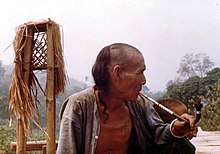
In the industrialized world, the United States is the world's biggest consumer of prescription opioids, with Italy being one of the lowest, because of tighter regulations on prescribing narcotics for pain relief.[146]Most opium imported into the United States is broken down into itsalkaloidconstituents, and whether legal or illegal, most current drug use occurs with processed derivatives such as heroin rather than with unrefined opium.
Intravenous injectionof opiates is most used: by comparison with injection, "dragon chasing" (heating of heroin on a piece of foil), andmadakand "ack ack" (smoking of cigarettes containing tobacco mixed with heroin powder) are only 40 percent and 20 percent efficient, respectively.[147]One study of British heroin addicts found a 12-fold excess mortality ratio (1.8 percent of the group dying per year).[148]Most heroin deaths result not from overdoseper se,but combination with other depressant drugs such asalcoholorbenzodiazepines.[149]
The smoking of opium does not involve theburningof the material as might be imagined. Rather, the prepared opium is indirectly heated to temperatures at which the active alkaloids, chiefly morphine, are vaporized. In the past, smokers would use a specially designedopium pipewhich had a removable knob-like pipe-bowl of fired earthenware attached by a metal fitting to a long, cylindrical stem.[150]A small "pill" of opium about the size of a pea would be placed on the pipe-bowl, which was then heated by holding it over anopium lamp,a special oil lamp with a distinct funnel-like chimney to channel heat into a small area. The smoker would lie on his or her side in order to guide the pipe-bowl and the tiny pill of opium over the stream of heat rising from the chimney of the oil lamp and inhale the vaporized opium fumes as needed. Several pills of opium were smoked at a single session depending on the smoker's tolerance to the drug. The effects could last up to twelve hours.
InEastern culture,opium is more commonly used in the form ofparegoricto treatdiarrhea.This is a weaker solution thanlaudanum,an alcoholic tincture which was prevalently used as a pain medication and sleeping aid. Tincture of opium has been prescribed for, among other things, severe diarrhea.[151]Taken thirty minutes prior to meals, it significantly slows intestinal motility, giving the intestines greater time to absorb fluid in the stool.
Despite the historically negative view of opium as a cause of addiction, the use of morphine and other derivatives isolated from opium in the treatment of chronic pain has been reestablished. If given in controlled doses, modern opiates can be an effective treatment forneuropathic painand other forms of chronic pain.[152]
Chemical and physiological properties
[edit]Opium contains two main groups ofalkaloids.Phenanthrenessuch asmorphine,codeine,andthebaineare the main psychoactive constituents.[153]Isoquinolinessuch aspapaverineandnoscapinehave no significantcentral nervous systemeffects. Morphine is the most prevalent and important alkaloid in opium, consisting of 10–16 percent of the total, and is responsible for most of its harmful effects such aslung edema,respiratory difficulties, coma, or cardiac or respiratory collapse. Morphine binds to and activatesmu opioid receptorsin the brain, spinal cord, stomach and intestine. Regular use can lead todrug toleranceorphysical dependence.Chronic opium addicts in 1906 China[49]consumed an average of eight grams of opium daily; opium addicts in modern Iran[154]are thought to consume about the same.
Bothanalgesiaanddrug addictionare functions of the mu opioid receptor, the class ofopioid receptorfirst identified as responsive to morphine. Tolerance is associated with the superactivation of the receptor, which may be affected by the degree ofendocytosiscaused by theopioidadministered, and leads to a superactivation ofcyclic AMPsignaling.[155]Long-term use of morphine inpalliative careand the management ofchronic painalways entails a risk that the patient develops tolerance or physical dependence. There are many kinds ofrehabilitation treatment,including pharmacologically based treatments withnaltrexone,methadone,oribogaine.[156]
In 2021, theInternational Agency for Research on Cancerconcluded that opium is a Group 1 (sufficient evidence) human carcinogen, causing cancers of the larynx, lung, and urinary bladder.[157]
Slang terms
[edit]Some slang terms for opium include: "Big O", "Shanghai Sally", "dope", "hop", "midnight oil", "O.P.", and "tar". "Dope" and "tar" can also refer to heroin. The traditional opium pipe is known as a "dream stick."[158]The termdopeentered the English language in the early nineteenth century, originally referring to viscous liquids, particularly sauces or gravy.[159]It has been used to refer to opiates since at least 1888, and this usage arose because opium, when prepared for smoking, is viscous.[159]
See also
[edit]- Golden Crescent
- Golden Triangle
- History of Jardine, Matheson & Co.
- Illegal drug trade in Colombia
- Mexican Drug War
- Nabidh
- Opium dollar
- Opium replacement
- Protocol for Limiting and Regulating the Cultivation of the Poppy Plant, the Production of, International and Wholesale Trade in, and Use of Opium
- Psychoactive drug
- Society for the Suppression of the Opium Trade
- Morphine
- Heroin
References
[edit]- ^abcdefghijPaul L. Schiff Jr. (2002)."Opium and its alkaloids".American Journal of Pharmaceutical Education.Archived fromthe originalon October 21, 2007.RetrievedMay 8,2007.
- ^Professor Arthur C. Gibson."The Pernicious Opium Poppy".University of California, Los Angeles.Archived fromthe originalon October 20, 2013.RetrievedFebruary 22,2014.
- ^"The Global Heroin Market"(PDF).October 2014.
- ^"Opium definition".Drugs.RetrievedFebruary 28,2015.
- ^"Etymonline - Opium".
- ^Simon O'Dochartaigh."HON Mother & Child Glossary, Meconium".hon.ch.Archived fromthe originalon May 1, 2021.RetrievedApril 4,2016.
- ^Sawynok J (January 1986). "The therapeutic use of heroin: a review of the pharmacological literature".Canadian Journal of Physiology and Pharmacology.64(1): 1–6.doi:10.1139/y86-001.PMID2420426.
- ^Merlin MD (September 2003)."Archaeological Evidence for the Tradition of Psychoactive Plant Use in the Old World".Economic Botany.57(3): 295–323.doi:10.1663/0013-0001(2003)057[0295:aeftto]2.0.co;2.ISSN0013-0001.JSTOR4256701.S2CID30297486.RetrievedMay 31,2022.
- ^PAPADAKI P. G. KRITIKOS, S. P."The history of the poppy and of opium and their expansion in antiquity in the eastern Mediterranean area".Unodc.org.UNODC- Bulletin on Narcotics – 1967 Issue 4 – 002.RetrievedMay 31,2022.
{{cite web}}:CS1 maint: multiple names: authors list (link) - ^Santella, Thomas M., Triggle, D. J. (2009).Opium.Facts On File, Incorporated. p. 8.ISBN978-1-4381-0213-9.
- ^Suzanne Carr (1995)."MS thesis".Archived fromthe originalon November 8, 2009.RetrievedMay 16,2007.(citing Andrew Sherratt)
- ^abcM J Brownstein (June 15, 1993)."A brief history of opiates, opioid peptides, and opioid receptors".Proceedings of the National Academy of Sciences of the United States of America.90(12): 5391–5393.Bibcode:1993PNAS...90.5391B.doi:10.1073/pnas.90.12.5391.PMC46725.PMID8390660.
- ^abcdPBS Frontline (1997)."The Opium Kings".PBS.RetrievedMay 16,2007.
- ^"Description of the Culture of the White Poppy and Preparation of Opium, as Practised in the Province of Bahar".The Asiatic Journal and Monthly Miscellany.Vol. 3. Wm. H. Allen & Company. 1817.RetrievedMay 31,2022.
- ^abP. G. Kritikos, S. P. Papadaki (January 1, 1967). "The early history of the poppy and opium".Journal of the Archaeological Society of Athens.
- ^E. Guerra Doce (January 1, 2006)."Evidencias del consumo de drogas en Europa durante la Prehistoria".Trastornos Adictivos(in Spanish).8(1): 53–61.doi:10.1016/S1575-0973(06)75106-6.S2CID145084811.Archived fromthe originalon May 15, 2008.RetrievedMay 10,2007.(includes image)
- ^Ibrahim B. Syed."Alcohol and Islam".RetrievedJuly 7,2005.
- ^"Islamic Medical Manuscripts at the National Library of Medicine: a note on pharmaceutics".RetrievedJune 6,2007.
- ^Julius Berendes (1902)."De Materia Medica"(in German). Archived fromthe originalon February 8, 2007.RetrievedMay 10,2007.
- ^abcdPhilip Robson (1999).Forbidden Drugs.Oxford University Press. p.161.ISBN978-0-19-262955-5.
- ^abcdefghCarl A. Trocki(2002)."Opium as a commodity and the Chinese drug plague"(PDF).Archived fromthe original(PDF)on July 20, 2008.RetrievedSeptember 13,2009.
- ^"Answers: al-Razi".Answers.
- ^"Abu Bakr Muhammad ibn Zakariya al-Razi (841–926)".Saudi Aramco World.January 2002.RetrievedJanuary 12,2008.
- ^"El Zahrawi – Father Of Surgery".Archived fromthe originalon September 27, 2007.RetrievedMay 4,2007.
- ^Heydari M, Hashempur MH, Zargaran A (2013). "Medicinal aspects of opium as described in Avicenna's Canon of Medicine".Acta medico-historica Adriatica.11(1): 101–12.PMID23883087.
- ^Smith RD (October 1980)."Avicenna and the Canon of Medicine: a millennial tribute".The Western Journal of Medicine.133(4): 367–70.PMC1272342.PMID7051568.
- ^Ganidagli S, Cengiz M, Aksoy S, Verit A (January 2004)."Approach to painful disorders by Şerefeddin Sabuncuoğlu in the fifteenth century Ottoman period".Anesthesiology.100(1): 165–9.doi:10.1097/00000542-200401000-00026.ISSN1528-1175.PMID14695738.S2CID27900838.RetrievedMay 31,2022.
- ^"Pseudo-Apuleius: Papaver".Archived fromthe originalon September 28, 2007.RetrievedJune 15,2007.
- ^ab"Paracelsus: the philosopher's stone made flesh".RetrievedMay 4,2007.
- ^"The devil's doctor".April 18, 2006.RetrievedMay 4,2007.
- ^"PARACELSUS, Five Hundred Years: Three American Exhibits".RetrievedJune 6,2007.
- ^Stephen Harding, Lee Ann Olivier, Olivera Jokic."Victorians' Secret: Victorian Substance Abuse".Archived fromthe originalon May 31, 2007.RetrievedMay 2,2007.
- ^Ole Daniel Enersen."Thomas Sydenham".RetrievedMay 2,2007.
- ^Lomax E (1973)."The Uses and Abuses Of Opiates In Nineteenth-Century England".Bulletin of the History of Medicine.47(2): 167–176.ISSN0007-5140.JSTOR44447528.PMID4584236.RetrievedMay 31,2022.
- ^abAurin M (January 1, 2000). "Chasing the Dragon: The Cultural Metamorphosis of Opium in the United States, 1825–1935".Medical Anthropology Quarterly.14(3): 414–441.doi:10.1525/maq.2000.14.3.414.JSTOR649506.PMID11036586.
- ^abKramer John C (1979). "Opium Rampant: Medical Use, Misuse and Abuse in Britain and the West in the 17th and 18th Centuries".British Journal of Addiction.74(4): 377–389.doi:10.1111/j.1360-0443.1979.tb01367.x.PMID396938.
- ^Donna Young (April 15, 2007)."Scientists Examine Pain Relief and Addiction".Archived fromthe originalon December 6, 2007.RetrievedJune 6,2007.
- ^"Drug Addiction Research and the Health of Women – pg. 33–52"(PDF).Archived fromthe original(PDF)on August 22, 2008.RetrievedMarch 21,2010.
- ^Zhang S (January 9, 2019)."Why a Medieval Woman Had Lapis Lazuli Hidden in Her Teeth".The Atlantic.RetrievedMay 10,2020.
- ^Garzoni, Costantino. 1840 [1573]. "Relazione dell'impero Ottomano del senatore Costantino Garzoni stato all'ambascieria di Costantinopoli nel 1573". In Le relazioni degli ambasciatori veneti al Senato, serie III, volume I, ed. Eugenio Albèri. Firenze: Clio, p. 398
- ^Hamarneh Sami (1972)."Pharmacy in medieval Islam and the history of drug addiction".Medical History.16(3): 226–237.doi:10.1017/s0025727300017725.PMC1034978.PMID4595520.
- ^Michot, Yahya.L’opium et le café. Traduction d’un texte arabe anonyme et exploration de l'opiophagie ottomane(Beirut: Albouraq, 2008)ISBN978-2-84161-397-7
- ^Matthee, Rudi.The Pursuit of Pleasure: Drugs and Stimulants in Iranian History, 1500–1900(Washington: Mage Publishers, 2005), pp. 97–116ISBN0-934211-64-7.Van de Wijngaart, G., "Trading in Dreams", in P. Faber & al. (eds.),Dreaming of Paradise: Islamic Art from the Collection of the Museum of Ethnology,Rotterdam, Rotterdam, Martial & Snoeck, 1993, p. 186-191.
- ^Habighorst, Ludwig V., Reichart, Peter A., Sharma, Vijay,Love for Pleasure: Betel, Tobacco, Wine and Drugs in Indian Miniatures(Koblenz: Ragaputra Edition, 2007)
- ^abcdefgDikotter F (2004).Narcotic Culture: A History of Drugs in China.Hurst. p. 3.ISBN978-0-226-14905-9.
- ^de Quincey T (1821).Confessions of an English Opium-Eater.p. 188.
- ^Hubble D (October 1957)."Opium Addiction and English Literature".Medical History.1(4): 323–35.doi:10.1017/s0025727300021505.PMC1034310.PMID13476921.
- ^abcYangwen Zheng (2003). "The Social Life of Opium in China, 1483–1999".Modern Asian Studies.37(1): 1–39.doi:10.1017/S0026749X0300101X.S2CID146582691.
- ^abcdeAlfred W. McCoy."Opium History, 1858 to 1940".Archived fromthe originalon April 4, 2007.RetrievedMay 4,2007.
- ^abRewriting history, A response to the 2008 World Drug Report,Transnational Institute, June 2008
- ^abCommissioner Jesse B. Cook(June 1931)."San Francisco's Old Chinatown".San Francisco Police and Peace Officers' Journal.RetrievedSeptember 22,2007.
- ^H.H. Kane, M.D. (September 24, 1881)."American Opium Smokers".RetrievedSeptember 22,2007.
- ^"Opium degrading the French Navy".April 27, 1913.RetrievedSeptember 22,2007.
- ^Alfred W. McCoy(1972)."The politics of heroin in Southeast Asia".Archived fromthe originalon October 7, 2007.RetrievedSeptember 24,2007.
- ^John Richards (May 23, 2001)."Opium and the British Indian Empire".RetrievedSeptember 24,2007.
- ^John Rennie (March 26, 2007)."When a woman ruled Chinatown".Tower Hamlets Newsletter. Archived fromthe originalon February 10, 2010.RetrievedMay 12,2007.
- ^J.P. Jones (February 1931)."Lascars in the port of London".P.L.A. Monthly.RetrievedMay 12,2007.
- ^"Opium in the West"ArchivedOctober 7, 2017, at theWayback Machine.Opium Museum.2007. Retrieved on September 21, 2007.
- ^"Brilliant, Chang! « London Particulars".Retrieved on October 3, 2010.
- ^"Opium timeline".The Golden Triangle. Archived fromthe originalon April 20, 2009.RetrievedSeptember 13,2009.
- ^"Opium Factories of Bihar – Bihargatha".Bihargatha.in. Archived fromthe originalon September 10, 2011.RetrievedOctober 7,2011.
- ^Wertz, Richard R."Qing Era (1644–1912)".iBiblio.1998. Retrieved on September 21, 2007.
- ^John K. Fairbanks, "The Creation of the Treaty System' in John K. Fairbanks, ed.The Cambridge History of China,vol. 10 Part 1 (Cambridge University Press, 1992) p. 213.cited inJohn Newsinger (October 1997)."Britain's opium wars – fact and myth about the opium trade in the East".Monthly Review.Archived fromthe originalon February 13, 2006.
- ^Bradley J (2009). "Chapter 10".The Imperial Cruise, a Secret History of Empire and War.Little, Brown. pp. 274–275.ISBN978-0316049665.
- ^Kathleen L. Lodwick (February 5, 2015).Crusaders Against Opium: Protestant Missionaries in China, 1874–1917.University Press of Kentucky. pp. 86–.ISBN978-0-8131-4968-4.
- ^Pierre-Arnaud Chouvy (2009).Opium: Uncovering the Politics of the Poppy.Harvard University Press. pp. 9–.ISBN978-0-674-05134-8.
- ^Dr Roland Quinault, Dr Ruth Clayton Windscheffel, Mr Roger Swift (July 28, 2013).William Gladstone: New Studies and Perspectives.Ashgate Publishing, Ltd. pp. 238–.ISBN978-1-4094-8327-4.
- ^Ms Louise Foxcroft (June 28, 2013).The Making of Addiction: The 'Use and Abuse' of Opium in Nineteenth-Century Britain.Ashgate Publishing, Ltd. pp. 66–.ISBN978-1-4094-7984-0.
- ^William Travis Hanes, Frank Sanello (2004).Opium Wars: The Addiction of One Empire and the Corruption of Another.Sourcebooks, Inc. pp. 78–.ISBN978-1-4022-0149-3.
- ^W. Travis Hanes III, Frank Sanello (February 1, 2004).The Opium Wars: The Addiction of One Empire and the Corruption of Another.Sourcebooks. pp. 88–.ISBN978-1-4022-5205-1.
- ^Peter Ward Fay (November 9, 2000).The Opium War, 1840–1842: Barbarians in the Celestial Empire in the Early Part of the Nineteenth Century and the War by which They Forced Her Gates Ajar.Univ of North Carolina Press. pp. 290–.ISBN978-0-8078-6136-3.
- ^Anne Isba (August 24, 2006).Gladstone and Women.A&C Black. pp. 224–.ISBN978-1-85285-471-3.
- ^David William Bebbington (1993).William Ewart Gladstone: Faith and Politics in Victorian Britain.Wm. B. Eerdmans Publishing. pp. 108–.ISBN978-0-8028-0152-4.
- ^Lodwick, Kathleen L. (1996).Crusaders Against Opium: Protestant Missionaries in China 1874–1917.University Press of Kentucky.ISBN0-8131-1924-3
- ^Windle J (2013)."'Harms Caused by China's 1906–17 Opium Suppression Intervention'"(PDF).International Journal of Drug Policy.24(5): 498–505.doi:10.1016/j.drugpo.2013.03.001.PMID23567100.
- ^Ellen N. La Motte."The opium monopoly".RetrievedSeptember 25,2007.
- ^Joyce A. Madancy (April 2004)."The Troublesome Legacy of Commissioner Lin".Archived fromthe originalon January 30, 2008.RetrievedSeptember 25,2007.
- ^Windle, J. (2011). ‘Ominous Parallels and Optimistic Differences: Opium in China and Afghanistan’. Law, Crime and History, Vol. 2(1), pp. 141–164.http://roar.uel.ac.uk/1692/
- ^William A Callahan (May 8, 2004)."Historical Legacies and Non/Traditional Security: Commemorating National Humiliation Day in China"(PDF).Archived fromthe original(PDF)on July 11, 2007.RetrievedJuly 8,2007.
- ^Ann Heylen (2004).Chronique du Toumet-Ortos: Looking through the Lens of Joseph Van Oost, Missionary in Inner Mongolia (1915–1921).Leuven, Belgium: Leuven University Press. p. 312.ISBN978-90-5867-418-0.RetrievedJune 28,2010.
- ^Association for Asian Studies. Southeast Conference (1979).Annals, Volumes 1–5.The Conference. p. 51.RetrievedApril 29,2011.
- ^Edward R. Slack (2001).Opium, State, and Society: China's Narco-Economy and the Guomindang, 1924–1937.Honolulu: University of Hawaii Press. p. 240.ISBN978-0-8248-2361-0.RetrievedJune 28,2010.
- ^Marc Andre Matten, ed. (December 9, 2011).Places of Memory in Modern China: History, Politics, and Identity.BRILL. p. 271.ISBN978-90-04-21901-4.
- ^Petr Parfenovich Vladimirov (1975).The Vladimirov diaries: Yenan, China, 1942–1945.Doubleday.ISBN978-0-385-00928-7.
- ^Chen Yung-Fa (1995)."The Blooming Poppy under the Red Sun: The Yan'an Way and the Opium Trade".In Tony Saich, Hans J. Van de Ven (eds.).New Perspectives on the Chinese Communist Revolution.M.E. Sharpe. pp. 263–298.ISBN978-1-56324-428-5.
- ^Hastings M(2007).Retribution.New York: Vintage. p. 413.ISBN978-0-307-27536-3.
- ^Liang B, Lu H (2013). "Discourses of drug problems and drug control in China: Reports in the People's Daily, 1946–2009".China Information.27(3): 302.doi:10.1177/0920203X13491387.S2CID147627658.
- ^Xiao S, Yang M, Zhou L, Hao W (February 2015)."Transition of China's drug policy: problems in practice".Addiction.110(2): 193–4.doi:10.1111/add.12689.PMID25602038.
- ^Hall W, Weier M (2017)."Lee Robins' studies of heroin use among US Vietnam veterans".Addiction.112(1): 177.doi:10.1111/add.13584.PMID27650054.S2CID206974500.RetrievedJuly 26,2022.
- ^Dale Gieringer (March 4, 2007)."State's War on Drugs – a 100-Year Bust".
- ^Peter McWilliams."Ain't Nobody's Business If You Do".Archived fromthe originalon May 25, 2007.
- ^Legal Information Access Centre."Drug laws in Australia".
- ^Carstairs C. (2006)."Jailed for Possession: Illegal Drug Use, Regulation, and Power in Canada, 1920–61".Archived fromthe originalon January 25, 2003.RetrievedMay 21,2007.
- ^Ladenburg T (1974)."Chapter 1, The French in Indochina"(PDF).University of Houston.Archived(PDF)from the original on March 1, 2023.RetrievedMarch 21,2023.
- ^Anderson S, Berridge V (2000). "Opium In 20th-Century Britain: Pharmacists, Regulation And The People".Addiction.95(1): 23–36.doi:10.1046/j.1360-0443.2000.951234.x.PMID10723823.
- ^abcdeBrown Richard Harvey (2002). "The Opium Trade And Opium Policies In India, China, Britain, And The United States: Historical Comparisons And Theoretical Interpretations".Asian Journal of Social Science.30(3): 623.doi:10.1163/156853102320945420.
- ^Office of the Commissioner."Legislation – Controlled Substances Act".Fda.gov.RetrievedJanuary 25,2017.
- ^"Opium – Poppy Cultivation, Morphine and Heroin Manufacture".Erowid.org.RetrievedJanuary 25,2017.
- ^Peter Dale Scott, Asia-Pacific Journal Japan Focus, 1 Nov. 2010, Volume 8 | Issue 44 | Number 2,"Operation Paper: The United States and Drugs in Thailand and Burma" Mễ quốc とタイ・ビルマ の ma dược
- ^Jennifer Hull (June 24, 2001)."Eastern Europe Shooting Up Under A Red Star".Time.Archived fromthe originalon February 24, 2021.RetrievedApril 17,2020.
- ^Morimoto S, Kazunari Suemori, Jun Moriwaki, Futoshi Taura, Hiroyuki Tanaka, Mariko Aso, Masakazu Tanaka, Hiroshi Suemune, Yasuyuki Shimohigashi, Yukihiro Shoyama, et al. (October 12, 2001)."Morphine Metabolism in the Opium Poppy and Its Possible Physiological Function".Journal of Biological Chemistry.276(41): 38179–38184.doi:10.1074/jbc.M107105200.PMID11498543.
- ^"Dem Morphin auf der Spur".Pharmazeutische-zeitung.de.RetrievedOctober 7,2011.
- ^Huxtable Ryan J., Schwartz Stephen K. W. (2001)."The Isolation of Morphine—First Principles in Science and Ethics".Molecular Interventions.1(4): 189–191.PMID14993340.
- ^Carter AJ (1996)."Narcosis and nightshade".The BMJ.313(7072): 1630–2.doi:10.1136/bmj.313.7072.1630.PMC2359130.PMID8991015.
- ^Judson HF (1974).Heroin Addiction.Vintage Books. p. 54.ISBN978-0-394-72017-3.
- ^Richard Askwith,The Sunday Times (September 13, 1998)."How aspirin turned hero".Archived fromthe originalon September 6, 2015.RetrievedMay 2,2007.
- ^"Operational Medicine 2001 Field Medical Service School Student Handbook: Molle medical bag/surgical instrument set".December 7, 1999.RetrievedJune 27,2007.
- ^"0.0_Front Matters_05-31-07.qxd"(PDF).RetrievedMarch 21,2010.
- ^Mark Corcoran."Afghanistan: America's blind eye".Australian Broadcasting Corporation.Archived fromthe originalon October 11, 2007.RetrievedMay 11,2007.
- ^"Afghan poppy farmers say new seeds will boost opium output".yahoo.RetrievedApril 4,2016.
- ^"Opium production in the Golden Triangle continues at high levels, threatening regional integration".unodc.org.RetrievedApril 4,2016.
- ^Kloosterman K (June 2, 2022)."Solar panels driving opium trade in Afghanistan".Greenprophet.RetrievedJune 11,2022.
- ^"Poppy Cultivation in South of Afghanistan Down by 80%: Report".ToloNews.June 7, 2023. p. 1.RetrievedJune 8,2023.
- ^ab"Afghan opium poppy cultivation plunges by 95 percent under Taliban: UN".Al Jazeera.RetrievedNovember 7,2023.
- ^ab"Opium cultivation declines by 95 per cent in Afghanistan: UN survey | UN News".news.un.org.November 5, 2023.RetrievedNovember 7,2023.
- ^Frick S, Kramell R, Schmidt J, Fist AJ, Kutchan TM (May 2005). "Comparative qualitative and quantitative determination of alkaloids in narcotic and condiment Papaver somniferum cultivars".Journal of Natural Products.68(5): 666–73.doi:10.1021/np0496643.PMID15921406.
- ^"Production of thebaine and oripavine".April 20, 2004. Archived fromthe originalon September 5, 2012.RetrievedMay 10,2007.
- ^Meadway C, George S, Braithwaite R (August 31, 1998). "Opiate concentrations following the ingestion of poppy seed products—evidence for 'the poppy seed defence'".Forensic Science International.96(1): 29–38.doi:10.1016/S0379-0738(98)00107-8.PMID9800363.
- ^Trafkowski J, Madea B, Musshoff F (August 2006). "The significance of putative urinary markers of illicit heroin use after consumption of poppy seed products".Therapeutic Drug Monitoring.28(4): 552–8.doi:10.1097/00007691-200608000-00011.PMID16885724.S2CID22585610.
- ^Albert D. Fraser, David Worth (October 1999)."Experience with a Urine Opiate Screening and Confirmation Cutoff of 2000 mg/ml".Journal of Analytical Toxicology.23(6): 549–551.doi:10.1093/jat/23.6.549.PMID10517566.
- ^Gahlinger 2001
- ^Anil Aggrawal(1995)."CHAPTER 2: THE STORY OF OPIUM".Narcotic Drugs.New Delhi: National Book Trust.ISBN978-81-237-1383-0.Archived fromthe originalon May 19, 2007.RetrievedMay 6,2007.
- ^"UNODC – Bulletin on Narcotics – 1969 Issue 4 – 001".Unodc.org.RetrievedJune 11,2022.
- ^abBelgische Farmacopee, 5de uitgave, 1966; part 3
- ^W. R. Martin, H. F. Fraser (September 1, 1961)."A comparative study of subjective and physiological effects of heroin and morphine administered intravenously in postaddicts".Journal of Pharmacology and Experimental Therapeutics.133(3): 388–399.PMID13767429.RetrievedJune 6,2007.
- ^Robinson SL, Rowbotham DJ, Smith G (July 1991)."Morphine compared with diamorphine. A comparison of dose requirements and side-effects after hip surgery".Anaesthesia.46(7): 538–40.doi:10.1111/j.1365-2044.1991.tb09650.x.PMID1862890.S2CID35289009.
- ^"Interpol".Archived fromthe originalon September 24, 2001.RetrievedMay 9,2006.
- ^"UNODC World Drug Report 2005"(PDF).RetrievedMay 2,2007.
- ^Jeff Sheehy, Corinna Kaarlela (January 26, 2004)."Black tar heroin use explains lower HIV levels among intravenous drug users in the Western U.S".RetrievedMay 24,2017.
- ^Paul Harris in Peshawar (November 25, 2001)."Victorious warlords set to open the opium floodgates".London: Observer.guardian.co.uk.RetrievedMarch 21,2010.
- ^"UN World Drug Report 2007 – Afghanistan"(PDF).RetrievedMarch 21,2010.
- ^"Rebuilding Afghanistan: Weekly Activity Update".February 24, 2005. Archived fromthe originalon May 9, 2007.RetrievedMay 11,2007.
- ^BBC News (August 2, 2006)."UN warns of soaring Afghan opium".RetrievedJune 6,2007.
- ^Goodhand J (2000). "From holy war to opium war? A case study of the opium economy in North Eastern Afghanistan".Central Asian Survey.19(2): 265–280.doi:10.1080/02634930050079354.PMID18348361.S2CID2591603.
- ^"International Narcotics Control Strategy Report: Chemical controls".RetrievedMay 11,2007.
- ^Brzezinski, Matthew. "Re-Engineering the Drug Business".The New York Times Magazine,June 23, 2002
- ^"UNODC"(PDF).RetrievedDecember 20,2023.
- ^"UNODC – Bulletin on Narcotics – 1950 Issue 3 – 003".United Nations: Office on Drugs and Crime.RetrievedMay 5,2021.
- ^"CENTRAL BUREAU OF NARCOTICS, INDIA".cbn.nic.in.RetrievedApril 4,2016.
- ^Pablo Bartholomew(1996)."Opium for the masses: photo essay on cultivation of opium in India".Archived fromthe originalon July 1, 2007.RetrievedJune 15,2007.
- ^Senlis Council."Feasibility Study on Opium Licensing in Afghanistan".Archived fromthe originalon September 28, 2007.
- ^Senlis Council (September 26, 2005)."The Kabul International Symposium on Drug Policy".Archived fromthe originalon March 13, 2007.RetrievedMay 4,2007.
- ^Poppy for Medicine: "Licensing poppy for the production of essential medicines: an integrated counter-narcotics, development, and counter-insurgency model for Afghanistan"ArchivedSeptember 28, 2007, at theWayback Machine.Senlis Council.June 2007. Retrieved on September 21, 2007.
- ^"Letter from Macfarlan Smith".Archived fromthe originalon March 22, 2009.RetrievedMarch 21,2010.
- ^The painkilling fields: England's opium poppies that tackle the NHS morphine crisis,Press releaseArchivedOctober 10, 2008, at theWayback Machine,September 15, 2007.
- ^S. Mercadante (1998)."Oral morphine consumption in Italy and Sicily".Journal of Pain and Symptom Management.15(4): 227–30.doi:10.1016/S0885-3924(98)00368-6.PMID9601157.
- ^Benjamin Pui-Nin Mo, E. Leong Way (October 1, 1966)."An Assessment Of Inhalation As A Mode Of Administration Of Heroin By Addicts".Journal of Pharmacology and Experimental Therapeutics.154(1): 142–151.PMID5924312.RetrievedJune 6,2007.
- ^Karl A. Sporer, M.D. (April 6, 1999). "Acute Heroin Overdose".Annals of Internal Medicine.130(7): 584–590.doi:10.7326/0003-4819-130-7-199904060-00019.PMID10189329.S2CID22949289.
- ^Darke S, Zador D (December 1996). "Fatal heroin 'overdose': a review".Addiction.91(12): 1765–72.doi:10.1046/j.1360-0443.1996.911217652.x.PMID8997759.
- ^"Anonymous Proxy".Softfamous.RetrievedJune 11,2022.
- ^"Laudanum".Archived fromthe originalon May 31, 2007.RetrievedMay 4,2007.
- ^Ballantyne, Jane C., and Jianren Mao. "Opioid Therapy For Chronic Pain".New England Journal of Medicine349.20 (n.d.): 1943–1953. SocINDEX with Full Text. Web. November 3, 2011.
- ^"Opiates".Homehealth-uk. Archived fromthe originalon October 31, 2011.RetrievedOctober 7,2011.
- ^Max Chamka, Translated by Geraldine Ring."3 grams of opium for 1 dollar".Caucaz europenews.RetrievedMay 6,2007.
- ^Finn AK, Whistler JL (December 2001)."Endocytosis of the mu opioid receptor reduces tolerance and a cellular hallmark of opiate withdrawal".Neuron.32(5): 829–39.doi:10.1016/S0896-6273(01)00517-7.PMID11738029.S2CID16396686.
- ^Alper KR, Lotsof HS, Kaplan CD (January 2008). "The ibogaine medical subculture".Journal of Ethnopharmacology.115(1): 9–24.doi:10.1016/j.jep.2007.08.034.PMID18029124.
- ^Volume 126: Opium ConsumptionVolume 126: Opium Consumption.
- ^"Opiate Slang Dictionary".That's Poppycock.Archived fromthe originalon April 9, 2010.RetrievedMay 1,2010.
- ^abDave Wilton,"dope"ArchivedOctober 2, 2016, at theWayback Machine,Wordorigins.org(5 January 2009).
Further reading
[edit]- Ahmad, Diana L.The Opium Debate and Chinese Exclusion Laws in the Nineteenth-century American West(University of Nevada Press, 2007). Drugs and Racism in the Old West.
- Armero and Rapaport.The Arts of an Addiction. Qing Dynasty Opium Pipes and Accessories(privately printed, 2005)
- Auerbach, Sascha.Race, Law and 'The Chinese Puzzle' in Imperial Britain.New York: Palgrave-Macmillan Press, 2009.
- Booth, Martin.Opium: A History.London: Simon & Schuster, Ltd., 1996.
- Chandra, Siddharth (2008)."Economic Histories of the Opium Trade".Archived fromthe originalon September 28, 2013.RetrievedNovember 9,2008.
- Chouvy, P.A. (2009)."Opium. Uncovering the Politics of the Poppy, London, I.B. Tauris (Cambridge, Harvard University Press: 2010)".Archived fromthe originalon October 26, 2011.RetrievedOctober 20,2009.
- Day, Horace B. (1868).The Opium Habit.
- de Quincey, Thomas (1821).Confessions of an English opium-eater.Standard Ebooks.
- Derks, Hans:History of the Opium Problem: The Assault on the East, ca. 1600–1950.Sinica Leidensia, 105. Leiden: Brill, 2012.ISSN0169-9563.ISBN978-90-04-22158-1
- Dikötter, Frank, Lars Laamann, and Zhou Xun.Narcotic culture: a history of drugs in ChinaChicago: University of Chicago Press, 2004.
- Dormandy, Thomas (2012)Opium: Reality's Dark Dream,Yale University Press
- Fairbank, J.K. (1978)The Cambridge History of China: volume 10 part I,Cambridge, CUP
- Franck Daninos,L'opium légal produit en France,La Recherche,May 2005
- Great Britain (1913).Agreement between Great Britain and Portugal for regulation of the opium monopolies of the colonies of Hong Kong and Macao.London, Printed for H.M. Stationery office. by Harrison and sons, ltd.
- Forbes, Andrew; Henley, David (2011).Traders of the Golden Triangle.Chiang Mai: Cognoscenti Books.ASINB006GMID5K
- Great Britain, India office (1922).The truth about Indian opium.[London] Printed by H.M. Stationery Off.
- Hai guan zong shui wu si shu (1889).The poppy in China.Shanghai; Statistical Dept. of the Inspectorate General of Customs.
- Hideyuki Takano;The Shore Beyond Good and Evil: A Report from Inside Burma's Opium Kingdom(2002, Kotan,ISBN0-9701716-1-7)
- Inglis, Lucy,Milk of Paradise: A History of Opium,Pan Macmillan, London, 2018. **Review: Julie Peakman: "Not Just Smelling the Flowers",History TodayHistory Today Vol. 68/10, October 2018, pp. 102–103.
- Latimer, Dean, and Jeff Goldberg with an Introduction by William Burroughs.Flowers in the Blood: The Story of Opium.New York: Franklin Watts, 1981
- MacPherson, Duncan (1843).Two years in China. Narrative of the Chinese expedition, from its formation in April, 1840, to the treaty of peace in August, 1842.London, Saunders.
- Martin, Steven.The Art of Opium Antiques.Chiang Mai: Silkworm Books, 2007. Photographs and history of Chinese and Vietnamese opium-smoking paraphernalia.
- McCoy, Alfred W.The Politics of Heroin: CIA Complicity in the Global Drug Trade.New York: Lawrence Hill Books, 1991.
- Merwin, Samuel (1907).Drugging a nation, the story of China and the opium curse; a personal investigation, during an extended tour, of the present conditions of the opium trade in China and its effects upon the nation.New York, Chicago [etc.]: F. H. Revell company.
- Morewood, Samuel (1838).A philosophical and statistical history of the inventions and customs of ancient and modern nations in the manufacture and use of inebriating liquors; with the present practice of distillation in all its varieties: together with an extensive illustration of the consumption and effects of opium, and other stimulants used in the East, as substitutes for wine and spirits.Dublin, W. Curry and W. Carson.
- William Muir(1875),The opium revenue: Sir William Muir's minute and other extracts from papers published by the Calcutta government; also extracts from parliamentary papers(1st ed.), London: The Anglo-Oriental Society for the Suppression of the Opium Trade, p. 30,WikidataQ19095804
- Musto, David F.The American Disease: Origins of Narcotic Control.New York: Oxford University Press, 1987.
- Nye, Gideon(1873).The morning of my life in China: comprising an outline of the history of foreign intercourse from the last year of the regime of honorable East India Company, 1833, to the imprisonment of the foreign community in 1839.
- Ouchterlony, John (1844).The Chinese war: an account of all the operations of the British forces from the commencement to the Treaty of Nanking.London: Saunders and Otley.
- Peters, Gretchen.Seeds of Terror: How Heroin is Bankrolling the Taliban and Al Qaeda,Thomas Dunne Books (2009).
- Speer, William (1870).The oldest and the newest empire: China and the United States.Hartford, Conn., S. S. Scranton and company; Philadelphia, Parmelee & co.; [etc., etc.]
- Thelwall, A. S. (1839).The iniquities of the opium trade with China; being a development of the main causes which exclude the merchants of Great Britain from the advantages of an unrestricted commercial intercourse with that vast empire. With extracts from authentic documents.London: Wm. H. Allen and Co.
- Turner, Frederick Storrs (1876).British opium policy and its results to India and China.London, S. Low, Marston, Searle, & Rivington.
External links
[edit]- A fleet of opium clippers on the River Ganges
- Confessions of a Poppy Tea addict
- DEA drug information:Opium, morphine, and heroin
- From Flowers to Heroin[dead link],CIA publication
- Erowid: Opium
- Opium in India
- Opium Made Easyby Michael Pollan (originally appeared inHarper's.)
- House of Opium museum
- BLTC Research:Speculations on the future of opioids
- Thailex photo:Traditional method of using opium in Thailand
- Tsur Shezaf, Witer, The Opium Growers of SinaiArchivedNovember 20, 2009, at theWayback Machine
- UNODC – United Nations Office on Drugs and Crime– Afghan Opium Survey 2009
- "The Alkaloids of Opium",Scientific American,20 July 1878, p. 36, historical account on the physiological effects of the first 16 known alkaloids


